Managed Extended Detection and Response (MXDR) has gained traction as a potential solution for organizations confronting sophisticated and dynamic cyber threats. It is a cybersecurity approach that aims to identify and counter security threats across various defensive layers and sources.
This technology combines threat intelligence and data from endpoints, networks, cloud platforms, and applications, along with security analytics to provide context and correlate security alerts. MXDR solution also incorporates automated detection and response mechanisms, as well as artificial intelligence and machine learning capabilities to improve security effectiveness and efficiency.
Report indicates that 86% of cybersecurity professionals believe Managed XDR represents the future of threat detection and response. As more organizations are switching to XDR, it's time for us to delve deep into trends that have emerged in 2024.

The image depicts that the managed security services market is expected to reach 52.9 billion by 2028. It is growing at the CAGR of 11.5 %.
Know These Futuristic Trends in Managed XDR
- Trend 1: Integration with AI and Machine Learning
AI and ML will continue to bring more enhancements to Managed XDR solutions in the year 2024. These technologies help to detect more complex threats given that they are capable of processing big data while looking for threats which a human analyst might not detect given the volume of information being processed.
According to a report, the AI in the cybersecurity market is projected to grow to $60.6 billion by 2026, at a Compound Annual Growth Rate (CAGR) of 21.9% . This growth underscores the increasing reliance on AI and ML in enhancing cybersecurity measures.
- Trend 2: Enhanced Threat Intelligence and Analytics
Some of the significant elements that require a priority solution include threat intelligence and analytics in managed security services. By the year 2024, developments in these fields shall have instituted preventive threat hunting and accelerated incident detection.
This in turn will improve TTP analysis leading to a better understanding of threat actors’ activities, and thus the emergence of new threats will be effectively countered.
According to the reports, organizations using threat intelligence and analytics tools experienced a 50% reduction in the time to detect and contain a data breach . This statistic emphasizes the value of investing in advanced threat intelligence capabilities.
- Trend 3: Expansion of Cloud-Based XDR Services
Since adoption of the cloud is persistent, Managed XDR services are changing with the cloud computing environment. Internet-based XDR solutions are scalable and flexible, which means business can change the approach to security with less investments in infrastructure.
According to reports, by the year 2025, about 85% of enterprises will follow a cloud-first principle, while more than 95% of new digital workloads will have been deployed on cloud-native platforms.This shift highlights the growing preference for cloud-native XDR services.
- Trend 4: Increased Adoption of Managed XDR among Medium to Small Companies
The increasing adoption of MXDR solutions among small and medium-sized businesses is noteworthy. MXDR, or managed extended detection and response, is a service model where XDR capabilities are provided by external vendors on a subscription basis.
This approach is particularly attractive to smaller enterprises that may not have the internal resources, knowledge, or infrastructure to implement and oversee XDR solutions independently. By opting for a managed security service provider, these businesses can access the advantages of XDR, such as enhanced threat visibility, detection capabilities, and incident response, without facing the challenges and expenses associated with deploying and maintaining these systems in-house.
- Trend 5: Adoption of XDR in SecOps
The close incorporation of XDR into Security Operations SecOps teams will remain a key development in 2024. XDR simplifies security operations by integrating many security tools, minimizes the confusion often caused by multiple solutions to security teams, and improves the working interaction between individuals in the security field.
A study found that organizations deploying XDR solutions reported a 50% reduction in the time needed to investigate and respond to security incidents . This efficiency boost is crucial for mitigating the impact of cyber threats.
- Trend 6: Focus on Endpoint and Network Security Convergence
The integration of endpoint and network security is going to become prominent in the year 2024. The managed XDR solutions include both EDR and NDR which will ensure that everyone has a combined security solution that has a clear view of the attack surface and adequate protections.
- Trend 7: Emphasizing on Zero Trust Security Frameworks
The Zero Trust security approach assumes that potential threats can originate from both external and internal sources within a network. XDR platforms that integrate Zero Trust principles conduct thorough verification of all access requests before permitting resource usage.
Integrating Zero Trust concepts into managed detection and response services requires ongoing surveillance and authentication of user identities, devices, and access requests. Through this approach, XDR platforms can implement rigorous access controls and ensure that only authorized individuals can interact with critical data and systems. This comprehensive verification helps reduce the risks associated with internal threats and lateral movement across the network.
Key Points on Managed XDR
- What are the primary characteristics of Managed XDR? In Managed XDR, the following advantages can be highlighted: receiving a unified view of the security activity at the endpoint, network, and cloud levels, improving threat detection and response, streamlining security operations, and using predictions to protect organizations from new threats.
- What are the differences between Managed XDR and SIEM solutions?
Managed XDR is different from the traditional SIEM solution, as it involves the unification of several security tools into one platform, automated threat detection, and response as well as the system’s shift from the reactive mode to the proactive mode based on threat hunting.
- What is the role of automation in Managed XDR?
Automation is fundamental in managed detection and response services as it automates various security procedures and coordinates action responses across the security tools, improves the response period to threats, and directs the security specialists to core concerns while dealing with threats and attacks.
- What steps can organizations take that will guarantee they meet regulatory requirements when using Managed XDR?
Compliance features and functions are typically incorporated in managed XDR solutions for identifying and ensuring end users’ compliance with regulations such as GDPR, HIPAA, and PCI DSS. These solutions allow for tracking the change history, real-time monitoring, and preparing incident response documentation to prove the compliance initiative.
-
To what extent should organizations consider choosing a Managed XDR provider?
Things to look at when choosing a Managed security services provider include; The experience and specialization in cybersecurity, flexibility and scalability of the solutions it offers, compatibility with other existing complementary systems, level of service guarantees (SLAs), adaptability to business requirements.
Preparing for the Future of Managed XDR
Check Your Current Security Level
To begin implementing Managed XDR, one must evaluate the organization’s security stance or risk profile as is. Determine areas in your current security that remain uncovered and find out how XDR can fill in the gaps. To arrive at the best decision on the appropriate XDR solution for your organization, carrying out a proper evaluation will be crucial.
Invest in Training and Skill Development
MXDR solutions are also expected to increase in capability in the years to come so ensuring your security has the right training for the coming advanced Managed XDR solutions is a wise move. Make sure that your team is familiar with the current state of XDR solutions and their application to gain as much value from these sophisticated systems as possible.
Collaborate with Trusted Vendors
When selecting Managed XDR providers, it is possible to cooperate with reliable companies, meaning access to new technologies and specialists. Deal with the providers that comprehend the security issues relevant to your industry and have the ability to provide solutions that correspond to your needs.
Appoint a proactive security strategy
Opt for a proactive security model based on monitoring, hunting threats, and conducting security incidents. Maximize the full range of benefits of Managed XDR solutions to be ready for new risks and keep security breaches’ consequences to a minimum.
Managed XDR Solution by Cybalt
MXDR is a dynamic and evolving field that is expected to advance significantly in the future. As it progresses, it will encounter new challenges and possibilities, necessitating ongoing innovation and flexibility. Rather than offering a universal approach, XDR will provide customized solutions tailored to each organization's specific requirements and preferences.
It will serve as a valuable way that enhances existing security measures and teams. It will function as an integrated and collaborative tool, requiring coordination among various stakeholders and participants in the security landscape. To know more about the MXDR solution, have a free consultation with team Cybalt.
By choosing to adopt the Managed XDR strategy, you can proceed with optimism towards the future and prepare your business for the challenges of the evolving threat landscape.
Other Blogs

From Nuclear Centrifuges To Machine Shops: Securing IoT
IoT or ‘the internet of things’ has been around for a lot longer than the buzzword
Read More


Demystifying XDR
As the capabilities of threat actors have increased so have the tools which we utilize to detect and respond to their activities.
Read More


Cybersecurity In A Post Pandemic World
As many cyber security practitioners will tell you, the most imminent and dangerous threat to any network are the employees accessing it.
Read More


